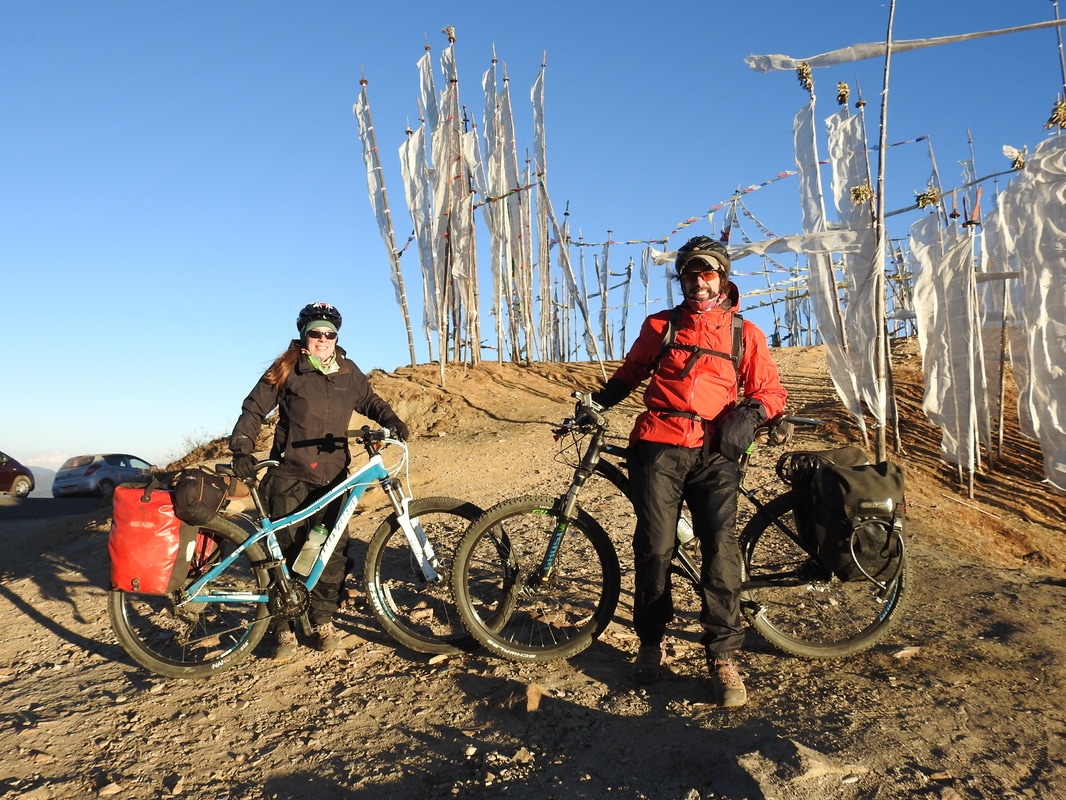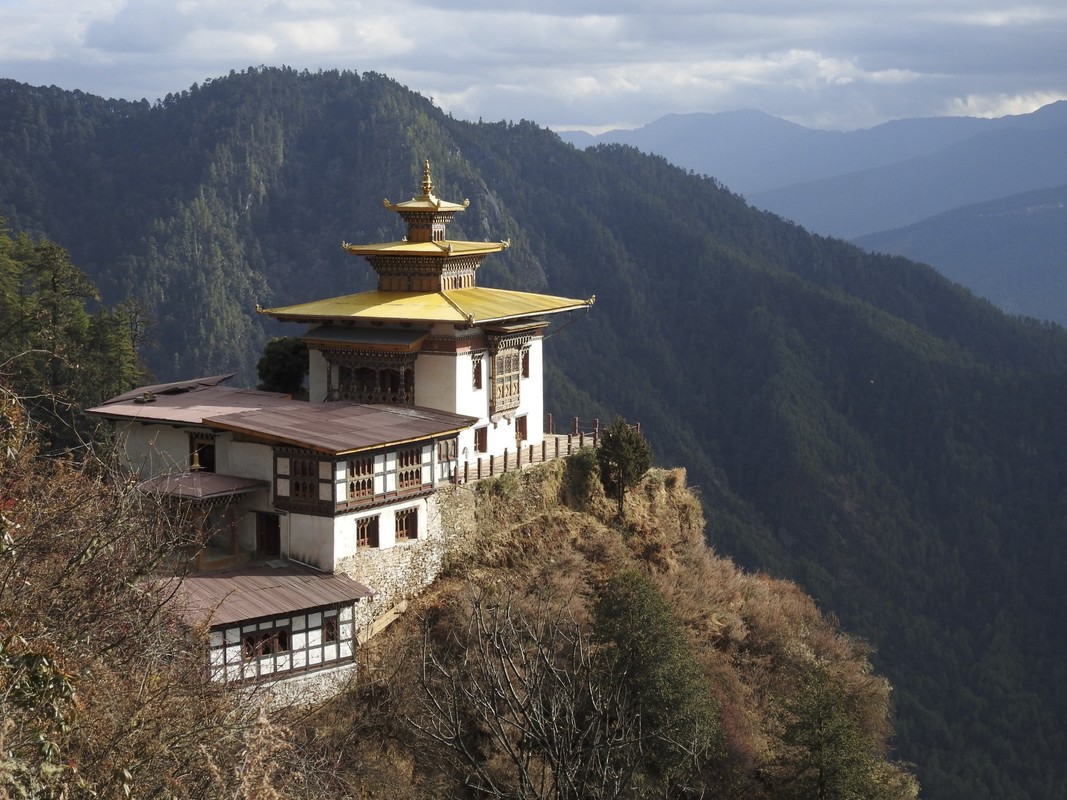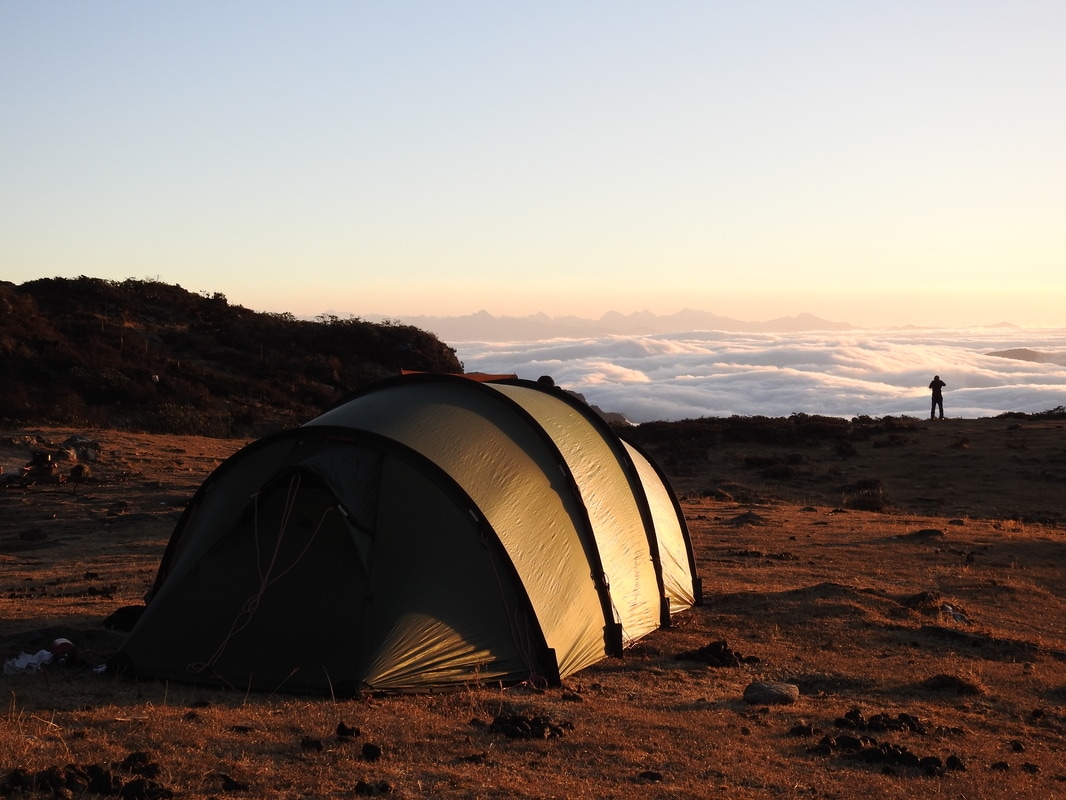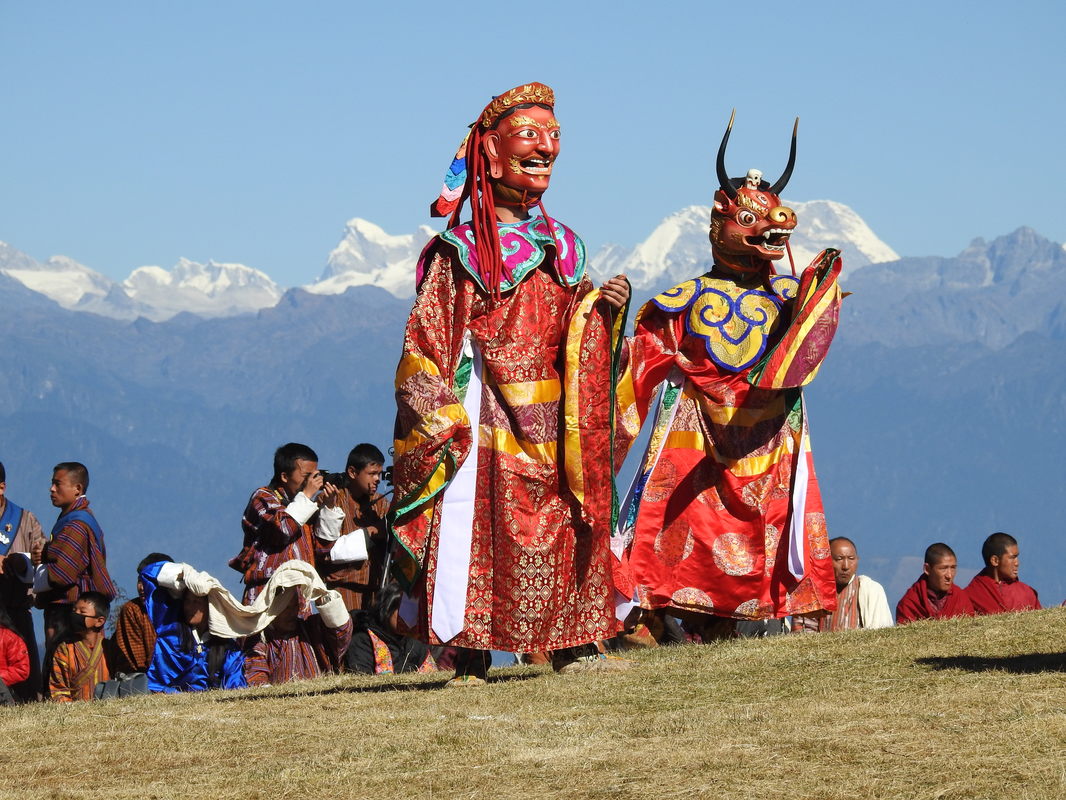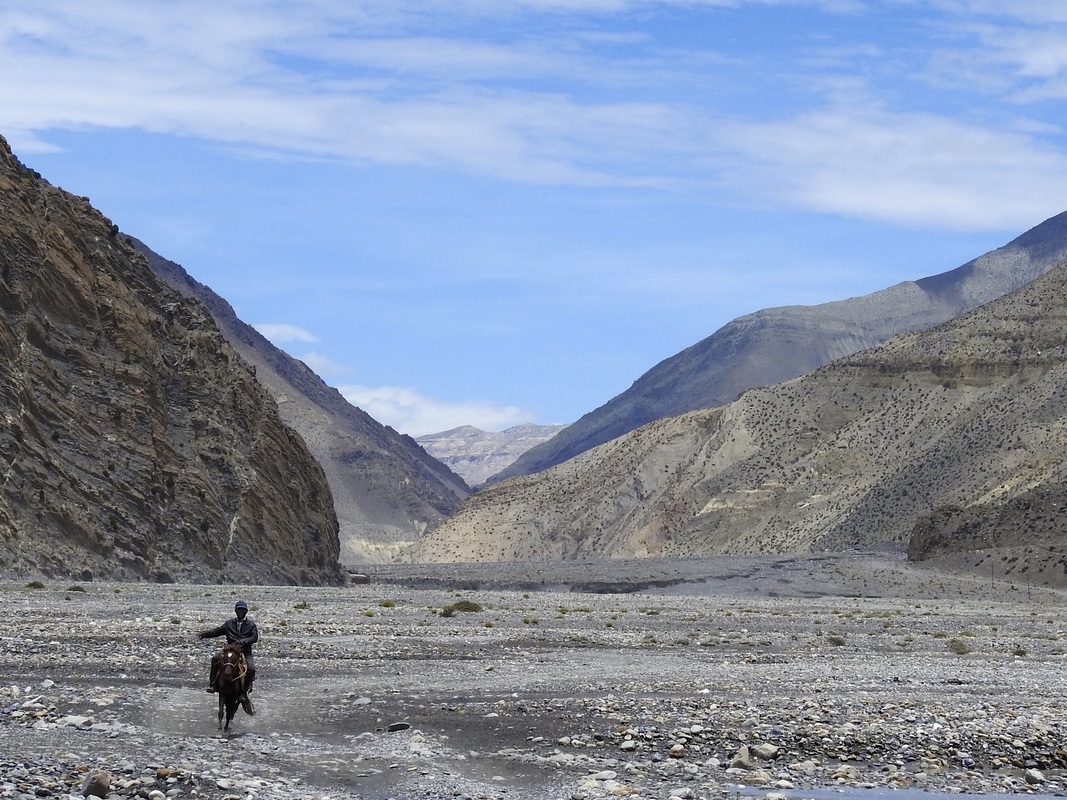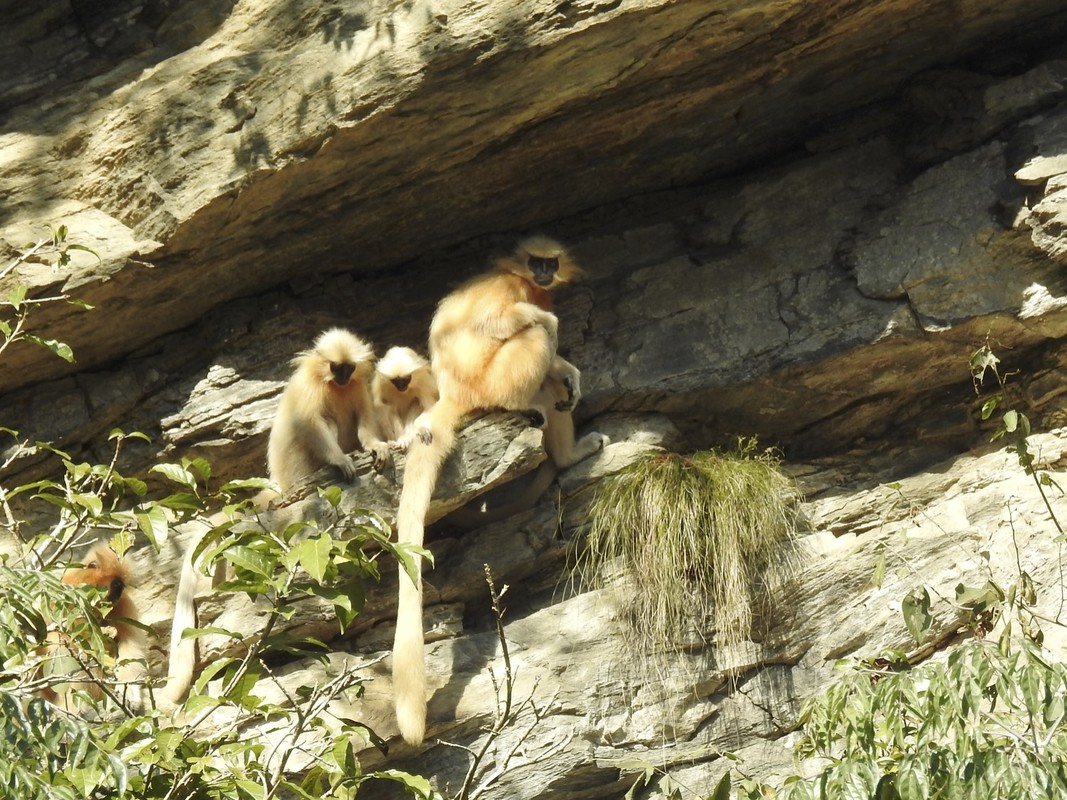
Now it was my turn to get the nasty cold and cough Matt had been fighting since leaving Thimphu. Therefore, I was in a bit of a daze on the early morning bus ride from Trongsa to our jumping off point to begin the Nabji-Korphu trek, a low-elevation route good for the wintertime to rural communities of the Mon and Kheng peoples. The Monpa are believed to be the first inhabitants of Bhutan, numbering around 3,000. They speak their own language and sustain elements of their pre-Buddhist animistic Bon religion along side contemporary Buddhist practice. We had been in communication Phurba, a local guide from the Jangbi, one of just a few Monpa villages within Jigme Dorji National Park. He met us shortly after we deboarded the bus, and after sorting out a little mix up with our permit situation to enter the National Park with a few phone calls, we began hiking toward his village.
Local people believe that seeing a langur monkey on your journey is good luck, whereas spotting a mischievous macaque monkey will bring the opposite upon you. So we took it as a good omen for our trek (and my health) that we passed by a tree full of the gorgeous golden langurs shortly after crossing the river into the Park. After a few hours of walking uphill, we reached Jangbi, seemingly just a few houses and several of which belonged to members of Phurba’s family. We took tea in the altar room and chatted with his sister. Eventually, she invited us in to the much warmer kitchen with a bukhari, but warned us that we might think it was “dirty”. By dirty, she meant undeveloped and it became apparent that the family was a little self-conscious about having chilip guests in their humble home. We did our best to put them at ease, sitting on the wood floor, playing with the…uh, how to say, not-so-clean kids, and enthusiastically tucking in to the super spicy food Phurba’s brother, Chimi, prepared over an open hearth. Just before dusk, we took a tour of their farm, learning what cardamom plants look like, that porcupine are nuisance to their crops, and wondering about the unharvested pomelos rotting on the ground.
At dinner, we were offered homemade ara and Phurba’s father shared a hardcover book with us that turned out to be an Indian grad student’s dissertation on the Monpa’s intimate relationship with their forest environment, something we would see in practice time and again as we continued the trek. Already, we had been served at dinner a bitter dish of cane shoot collected from the forest. Phurba’s family had been interviewed in the data collection and thus received a copy of the dissertation in appreciation. I would have loved to review the research in more depth, but I was heading toward serious dysfunctionality with my cold, so we excused ourselves for an 8 o’clock bedtime.
We bid farewell to the family the next morning and set off with Phurba and Chimi into the jungle. I was grateful that the trek was not so strenuous since I was struggling for energy despite 11 hours of sleep and Dayquil in my system. We encountered golden langurs several times, as well as a striking rufous-necked hornbill. After a hot packed lunch at an overlook of the valley marked by a chorten, we passed by a historical site where Guru Rinpoche had meditated, the evidence being an imprint of his (quite large) head in an overhanging rock. He also left a few footprints and fingerprints in an impassable cliff face that he cut a path through.
About seven hours after departing, we reached the trekker’s campsite at Kudra, not quite as nicely maintained as the one in Jangbi that Phurba’s family is in charge of. There was no water and the boys had forgotten matches to start a fire, so they ran off to the two-house village to connect some hoses and borrow matches. Dinner included some wild spinach that they harvested along the trail. We ate next to a cozy campfire until a light rain sent us to bed in the cooking shelter since we did not bring a tent for this trek.
We visited four more historical sites of Guru Rinpoche’s adventures while trekking toward the village of Nabji the next day. The first was a cave system of tight passageways said to emerge at Kurjey Lhakhang in Bumthang, near where we live. In this one, we also encountered a tremendously scary spider on the wall where we had been bracing with our hands, but happily it did not move as we inspected it. Another was a deep bore hole in a rock, actually a phallus imprint where the mighty Guru had “subdued” a demoness. We had planned on camping in Nabji as well, but we found the campsite to be in disarray. Cows had been splatter painting with their poop inside the shelter where we would need to sleep and again there was no water. We sought out a homestay and learned that the village committee had decided that trekkers must stay in houses rather than camp, likely to generate more income for the community.
Local people believe that seeing a langur monkey on your journey is good luck, whereas spotting a mischievous macaque monkey will bring the opposite upon you. So we took it as a good omen for our trek (and my health) that we passed by a tree full of the gorgeous golden langurs shortly after crossing the river into the Park. After a few hours of walking uphill, we reached Jangbi, seemingly just a few houses and several of which belonged to members of Phurba’s family. We took tea in the altar room and chatted with his sister. Eventually, she invited us in to the much warmer kitchen with a bukhari, but warned us that we might think it was “dirty”. By dirty, she meant undeveloped and it became apparent that the family was a little self-conscious about having chilip guests in their humble home. We did our best to put them at ease, sitting on the wood floor, playing with the…uh, how to say, not-so-clean kids, and enthusiastically tucking in to the super spicy food Phurba’s brother, Chimi, prepared over an open hearth. Just before dusk, we took a tour of their farm, learning what cardamom plants look like, that porcupine are nuisance to their crops, and wondering about the unharvested pomelos rotting on the ground.
At dinner, we were offered homemade ara and Phurba’s father shared a hardcover book with us that turned out to be an Indian grad student’s dissertation on the Monpa’s intimate relationship with their forest environment, something we would see in practice time and again as we continued the trek. Already, we had been served at dinner a bitter dish of cane shoot collected from the forest. Phurba’s family had been interviewed in the data collection and thus received a copy of the dissertation in appreciation. I would have loved to review the research in more depth, but I was heading toward serious dysfunctionality with my cold, so we excused ourselves for an 8 o’clock bedtime.
We bid farewell to the family the next morning and set off with Phurba and Chimi into the jungle. I was grateful that the trek was not so strenuous since I was struggling for energy despite 11 hours of sleep and Dayquil in my system. We encountered golden langurs several times, as well as a striking rufous-necked hornbill. After a hot packed lunch at an overlook of the valley marked by a chorten, we passed by a historical site where Guru Rinpoche had meditated, the evidence being an imprint of his (quite large) head in an overhanging rock. He also left a few footprints and fingerprints in an impassable cliff face that he cut a path through.
About seven hours after departing, we reached the trekker’s campsite at Kudra, not quite as nicely maintained as the one in Jangbi that Phurba’s family is in charge of. There was no water and the boys had forgotten matches to start a fire, so they ran off to the two-house village to connect some hoses and borrow matches. Dinner included some wild spinach that they harvested along the trail. We ate next to a cozy campfire until a light rain sent us to bed in the cooking shelter since we did not bring a tent for this trek.
We visited four more historical sites of Guru Rinpoche’s adventures while trekking toward the village of Nabji the next day. The first was a cave system of tight passageways said to emerge at Kurjey Lhakhang in Bumthang, near where we live. In this one, we also encountered a tremendously scary spider on the wall where we had been bracing with our hands, but happily it did not move as we inspected it. Another was a deep bore hole in a rock, actually a phallus imprint where the mighty Guru had “subdued” a demoness. We had planned on camping in Nabji as well, but we found the campsite to be in disarray. Cows had been splatter painting with their poop inside the shelter where we would need to sleep and again there was no water. We sought out a homestay and learned that the village committee had decided that trekkers must stay in houses rather than camp, likely to generate more income for the community.
Our host, as well as the entire village, was in “celebration mode” thanks to the annual tshechu beginning the day before. We seemed to have a knack for happening upon these events. After Chimi took over the kitchen and we ate dinner, we headed down to the village’s temple for the evening session of masked dances, featuring a rare ter cham, or treasure dance. Before we arrived to the courtyard, Phurba emphasized that we could not take photos of this particular dance, and we clearly agreed. He reminded us several more times while we watched other dances leading up to it, and each time we reassured him we would not pull out our cameras or our phones. Then, an atsara (festival clown) came over to let us know there would be a “special” dance that we could not photograph. Laso (okay), no problem. Not long after that, a fire marshal type looking man introduced himself, then got right to the point of officially informing us there could be no photos. Yes sir, no photos. During a pause between performances, an announcement was made to the entire audience regarding the ban on photography for the next dance. Phurba translated for us, and we nodded in concurrence, then he translated it two more times just to be sure.
Finally, the lights in the courtyard were shut off, and only the glow of fire in the middle of the dance floor remained. A group of men and, surprisingly for us, young boys emerged from a nearby building wearing white cloths tied around their heads and…(almost) nothing else. The men wore a thong-like string configuration with their bare “treasure” tied up to it, so that it was better on display, I suppose. Many treasures were also decorated with puffs of fluffy feathers, colorful strings, perhaps bells. It was a little difficult to see the details in the dark. They whooped, hollered, and clanged bells as they danced, then took turns running around the perimeter of the dance area, pausing to energetically shake what they got. The younger boys left the dance as things got more intense, but returned towards the end to be part of the phallus blessing. The naked dancers formed a circle around the fire, and women of all ages walked clockwise within it, in a continuous bow to the men’s honored parts. In the fall, we had also witnessed a more sexualized and homoerotic version of this ter cham during the Jambay Lhakhang tshechu in Bumthang. It made this one seem tame in comparison. Nonetheless, seeing elderly women being blessed by the penises of boys who could be their grandchildren was one of those fascinating moments of travel that required a large helping of cultural relativism to appreciate.
Apparently, the naked dance originated in this village and the neighboring village of Korphu in the 8th century. According to one travel company’s website, “legend has it that a band of devils were obstructing the construction of a Lhakhang (temple) in Nabjikorphu, delaying the work. As a ruse and to distract the devils, Terton Dorji Lingpa launched the naked dance. It served its purpose as the outrageous antics of the naked dancers kept the devils spellbound. The construction was thus completed. The dance reached Jambay Lhakhang since Terton Dorji Lingpa also consecrated [it].” A Terton is a treasure revealer, and refers to finding hidden scriptures and other religious artifacts, often in natural features like caves, as well as having dances such as this one revealed to their consciousness during deep meditations. Another travel company website claims, “The locals…believe that the penis is one of the most precious treasures, as all sentient beings are brought into the world by this organ.” Hmmm, interesting, because I can think of one other organ that might fit that description as well…
On the way back to our homestay, I considered playing a joke on Phurba by asking him if he’d like to see the amazing photos I took of the naked dance. I thought better of it though, fearing that if any other villagers overheard me, I might get instantly pummeled. And in a moment of sweet irony, we had spotted the pushy chilip photographer from the Trongsa tshechu at the naked dance as well, forced to actually stand back and watch something without his righteous tool to behave like a jack ass with.
We thought it was a little odd that two neighboring villages held their tshechus on the exact same dates until we learned from a German anthropologist studying the Korphu tshechu that they used to be staggered so both villages could attend the other's. A rivalry in recent years has caused them to competitively claim the same dates. We were trying not to play favorites though, and also wanted to explore another village, so we hiked for a couple of hours up to Korphu. After touring the village with Phurba’s monk friend and being offered some fresh homebrew known as singchang along the way, we entered the courtyard for the smallest tshechu we had ever seen with no more than fifty people in attendance. Despite this, we were intrigued that the atsaras were all about using a microphone hooked up to a large and in charge sound system, and got confirmation that this was a new adaptation as a result of the recently constructed road to the village. Like Nabji, there was also much more involvement of children in the tshechu than we had seen at the larger ones, from child atsaras to a lunch break karaoke/dance hour featuring most of the kids in the village.
We were so in love with this tshechu that we didn’t return to Nabji until its daytime festivities were wrapping up. However, just as we settled in to the kitchen for dinner at our homestay, we were informed that we needed to get out of the house because it would be “danger” to remain inside. Given our communication challenges with Phurba, the best we could surmise was that an intense fire ritual was about to be performed that could catch the house on fire. We rushed down to the Lhakhang just in time to watch a procession bringing down torma to eventually throw into a huge bonfire in the field below. We thus concluded the risk of remaining in the house was in a spiritual sense rather than a practical reality. The evening’s program continued with a very repetitive but endlessly humorous play, at least for those who could understand it. We sipped ara for our amusement instead, as well as to guard against the dropping temperature. Feeling a bit tshechu-ed out for the day, we took our leave just as a community dinner was being served, followed by more dances late into the night, of course. It seems these rural communities really go all out for their tshechus!
The following morning our packing routine was interrupted by Phurba excitedly busting in to our room to inform us of an old Monpa woman performing a shamanic ritual to rid a neighboring house of sickness. We were welcomed to observe the chanting and drumming on the deck of the house for a while, then returned to our hosts' house to settle up. Down at the Lhakhang, the tshechu was getting underway with blessing ceremonies. After getting some crowd-pleasing special attention from the atsaras, we joined the line to receive a blessing from the presiding rinpoche and another from a phallus presumably dipped in holy water. Afterwards, the women were getting picked up and twirled around by the men. I was no exception as the husband of the couple who hosted us grabbed me, although he noticeably went easy on me.
With that unexpected experience as our grand finale, we gave final assurances to multiple inquiries of which local tshechu was better that BOTH had been uniquely amazing, then started our hike down the road leading out of Nabji. While we were certainly honored to have witnessed these intimate community traditions up close and personal, our enthusiasm was ultimately no match for Phurba’s. He had not been to either of these Khengpa villages for eight years, yet he was constantly bumping into old classmates, friends, and acquaintances for whom he remembered exactly how they knew each other.
After all of the festivities of the few days, we were grateful for the simple, quiet movement of an easy hike down the road to the village of Nimshong. We noticed Chimi snapping off a couple of fern fiddleheads as he walked ahead of us and wondered if nakey would be on the dinner menu. When he answered in the affirmative, Matt pointed out that he would need to find a whole lot more. A grin spread across his face as he opened up the fold of his gho to reveal a heap of young fern fronds tucked inside. As we approached Nimshong late in the afternoon, Phurba informed us that we would ask around to stay in a house rather than using the campground as we had expected. We were a bit put off by this sudden change in plans, not because Nimshong appeared far less prosperous than Nabji and Korphu with its unadorned stilted wooden houses, but rather we were feeling saturated with wonderful but energy-intensive social interactions and were hoping for a more relaxing evening. Phurba put forth various reasons, but what it really came down to is that, except for the nakey collected on the hike, they were low on provisions.
After settling in to the altar room of a sweet old woman’s house, we were plied with tea and local mandarin oranges. Then Phurba informed us we had been invited to the annual prayer ritual at another house, similar to what we had experienced at the Haa Valley Homestay. We rallied our energy for the opportunity, amazed at how much ritual we had stumbled upon during this trek. We sat outside of their altar room and sipped ara while the monks prayed and played instruments inside. When the ceremony had finished, we were served bowls of rice topped with thick strips of chewy pork fat, considered the best part of the pig in Bhutan. We made a weak effort, but it was pretty difficult to stomach. Luckily, Chimi had also been cooking up the fiddleheads and other dishes for dinner back at our host’s home, so we excused ourselves for a second dinner. When we returned to the house having the annual ritual afterward, the mood had definitely turned purely celebratory and we were soon pulled into the circle of dancing in the tiny altar room. We captivated the attention of a very drunk young woman who repeatedly insisted that her (4-5 year old) “baby” told her that we were his true parents and that we needed to take her baby home with us. When this claim was less effective that she had hoped, she then tried to get us to come to her house to give us oranges. Phurba tried to help, but “My baby is sleeping. You are his momma.” persisted while firmly grabbing my hand, so we got out of there after just a few dances.
The following morning, we rejoined with the main road running through Zhemgang and had our “divorce” with Phurba (and Chimi) as he called it, sealing the deal with a shot of whiskey at a roadside shop since they did not have ara. They caught a bus heading north back toward their village shortly thereafter. We were left once again on our own, sitting on the side of the road, but this time without the benefit of our trusty two-wheeled companions to help us get to where we were trying to go next…
Finally, the lights in the courtyard were shut off, and only the glow of fire in the middle of the dance floor remained. A group of men and, surprisingly for us, young boys emerged from a nearby building wearing white cloths tied around their heads and…(almost) nothing else. The men wore a thong-like string configuration with their bare “treasure” tied up to it, so that it was better on display, I suppose. Many treasures were also decorated with puffs of fluffy feathers, colorful strings, perhaps bells. It was a little difficult to see the details in the dark. They whooped, hollered, and clanged bells as they danced, then took turns running around the perimeter of the dance area, pausing to energetically shake what they got. The younger boys left the dance as things got more intense, but returned towards the end to be part of the phallus blessing. The naked dancers formed a circle around the fire, and women of all ages walked clockwise within it, in a continuous bow to the men’s honored parts. In the fall, we had also witnessed a more sexualized and homoerotic version of this ter cham during the Jambay Lhakhang tshechu in Bumthang. It made this one seem tame in comparison. Nonetheless, seeing elderly women being blessed by the penises of boys who could be their grandchildren was one of those fascinating moments of travel that required a large helping of cultural relativism to appreciate.
Apparently, the naked dance originated in this village and the neighboring village of Korphu in the 8th century. According to one travel company’s website, “legend has it that a band of devils were obstructing the construction of a Lhakhang (temple) in Nabjikorphu, delaying the work. As a ruse and to distract the devils, Terton Dorji Lingpa launched the naked dance. It served its purpose as the outrageous antics of the naked dancers kept the devils spellbound. The construction was thus completed. The dance reached Jambay Lhakhang since Terton Dorji Lingpa also consecrated [it].” A Terton is a treasure revealer, and refers to finding hidden scriptures and other religious artifacts, often in natural features like caves, as well as having dances such as this one revealed to their consciousness during deep meditations. Another travel company website claims, “The locals…believe that the penis is one of the most precious treasures, as all sentient beings are brought into the world by this organ.” Hmmm, interesting, because I can think of one other organ that might fit that description as well…
On the way back to our homestay, I considered playing a joke on Phurba by asking him if he’d like to see the amazing photos I took of the naked dance. I thought better of it though, fearing that if any other villagers overheard me, I might get instantly pummeled. And in a moment of sweet irony, we had spotted the pushy chilip photographer from the Trongsa tshechu at the naked dance as well, forced to actually stand back and watch something without his righteous tool to behave like a jack ass with.
We thought it was a little odd that two neighboring villages held their tshechus on the exact same dates until we learned from a German anthropologist studying the Korphu tshechu that they used to be staggered so both villages could attend the other's. A rivalry in recent years has caused them to competitively claim the same dates. We were trying not to play favorites though, and also wanted to explore another village, so we hiked for a couple of hours up to Korphu. After touring the village with Phurba’s monk friend and being offered some fresh homebrew known as singchang along the way, we entered the courtyard for the smallest tshechu we had ever seen with no more than fifty people in attendance. Despite this, we were intrigued that the atsaras were all about using a microphone hooked up to a large and in charge sound system, and got confirmation that this was a new adaptation as a result of the recently constructed road to the village. Like Nabji, there was also much more involvement of children in the tshechu than we had seen at the larger ones, from child atsaras to a lunch break karaoke/dance hour featuring most of the kids in the village.
We were so in love with this tshechu that we didn’t return to Nabji until its daytime festivities were wrapping up. However, just as we settled in to the kitchen for dinner at our homestay, we were informed that we needed to get out of the house because it would be “danger” to remain inside. Given our communication challenges with Phurba, the best we could surmise was that an intense fire ritual was about to be performed that could catch the house on fire. We rushed down to the Lhakhang just in time to watch a procession bringing down torma to eventually throw into a huge bonfire in the field below. We thus concluded the risk of remaining in the house was in a spiritual sense rather than a practical reality. The evening’s program continued with a very repetitive but endlessly humorous play, at least for those who could understand it. We sipped ara for our amusement instead, as well as to guard against the dropping temperature. Feeling a bit tshechu-ed out for the day, we took our leave just as a community dinner was being served, followed by more dances late into the night, of course. It seems these rural communities really go all out for their tshechus!
The following morning our packing routine was interrupted by Phurba excitedly busting in to our room to inform us of an old Monpa woman performing a shamanic ritual to rid a neighboring house of sickness. We were welcomed to observe the chanting and drumming on the deck of the house for a while, then returned to our hosts' house to settle up. Down at the Lhakhang, the tshechu was getting underway with blessing ceremonies. After getting some crowd-pleasing special attention from the atsaras, we joined the line to receive a blessing from the presiding rinpoche and another from a phallus presumably dipped in holy water. Afterwards, the women were getting picked up and twirled around by the men. I was no exception as the husband of the couple who hosted us grabbed me, although he noticeably went easy on me.
With that unexpected experience as our grand finale, we gave final assurances to multiple inquiries of which local tshechu was better that BOTH had been uniquely amazing, then started our hike down the road leading out of Nabji. While we were certainly honored to have witnessed these intimate community traditions up close and personal, our enthusiasm was ultimately no match for Phurba’s. He had not been to either of these Khengpa villages for eight years, yet he was constantly bumping into old classmates, friends, and acquaintances for whom he remembered exactly how they knew each other.
After all of the festivities of the few days, we were grateful for the simple, quiet movement of an easy hike down the road to the village of Nimshong. We noticed Chimi snapping off a couple of fern fiddleheads as he walked ahead of us and wondered if nakey would be on the dinner menu. When he answered in the affirmative, Matt pointed out that he would need to find a whole lot more. A grin spread across his face as he opened up the fold of his gho to reveal a heap of young fern fronds tucked inside. As we approached Nimshong late in the afternoon, Phurba informed us that we would ask around to stay in a house rather than using the campground as we had expected. We were a bit put off by this sudden change in plans, not because Nimshong appeared far less prosperous than Nabji and Korphu with its unadorned stilted wooden houses, but rather we were feeling saturated with wonderful but energy-intensive social interactions and were hoping for a more relaxing evening. Phurba put forth various reasons, but what it really came down to is that, except for the nakey collected on the hike, they were low on provisions.
After settling in to the altar room of a sweet old woman’s house, we were plied with tea and local mandarin oranges. Then Phurba informed us we had been invited to the annual prayer ritual at another house, similar to what we had experienced at the Haa Valley Homestay. We rallied our energy for the opportunity, amazed at how much ritual we had stumbled upon during this trek. We sat outside of their altar room and sipped ara while the monks prayed and played instruments inside. When the ceremony had finished, we were served bowls of rice topped with thick strips of chewy pork fat, considered the best part of the pig in Bhutan. We made a weak effort, but it was pretty difficult to stomach. Luckily, Chimi had also been cooking up the fiddleheads and other dishes for dinner back at our host’s home, so we excused ourselves for a second dinner. When we returned to the house having the annual ritual afterward, the mood had definitely turned purely celebratory and we were soon pulled into the circle of dancing in the tiny altar room. We captivated the attention of a very drunk young woman who repeatedly insisted that her (4-5 year old) “baby” told her that we were his true parents and that we needed to take her baby home with us. When this claim was less effective that she had hoped, she then tried to get us to come to her house to give us oranges. Phurba tried to help, but “My baby is sleeping. You are his momma.” persisted while firmly grabbing my hand, so we got out of there after just a few dances.
The following morning, we rejoined with the main road running through Zhemgang and had our “divorce” with Phurba (and Chimi) as he called it, sealing the deal with a shot of whiskey at a roadside shop since they did not have ara. They caught a bus heading north back toward their village shortly thereafter. We were left once again on our own, sitting on the side of the road, but this time without the benefit of our trusty two-wheeled companions to help us get to where we were trying to go next…

